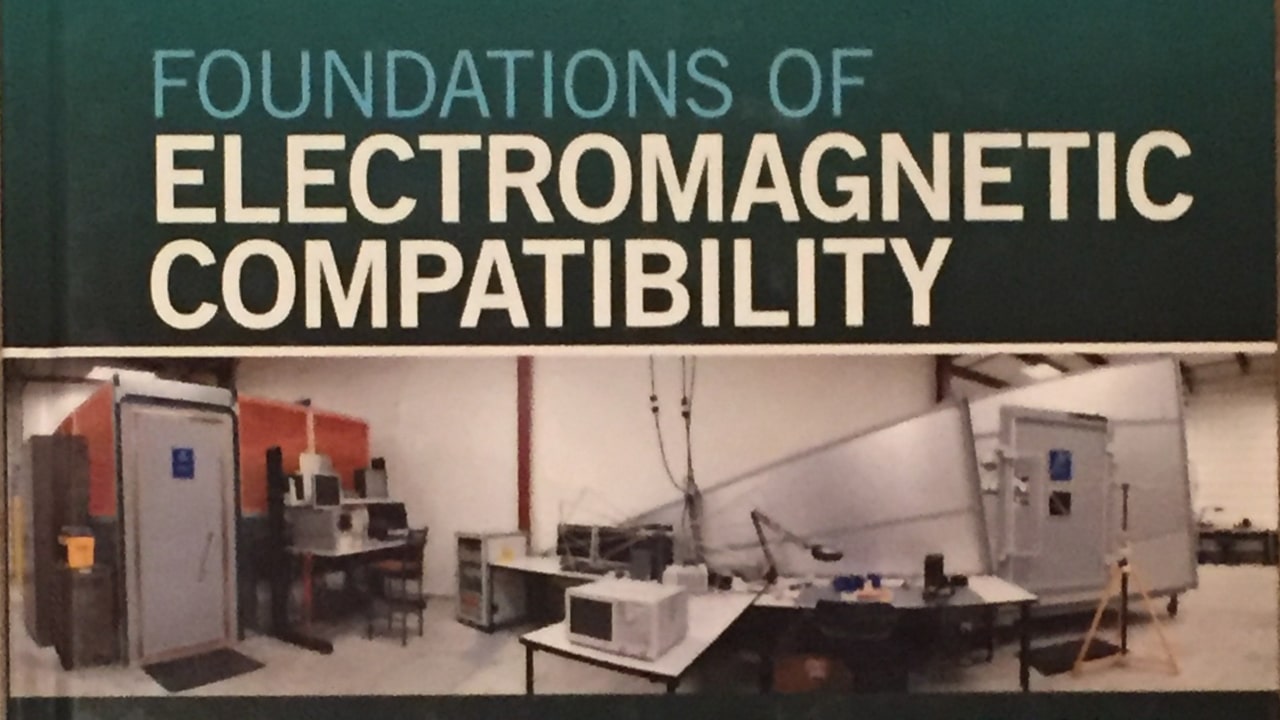OK, this is not a book for the faint-hearted. Bogdan Adamczyk is a professor of engineering and the founder of the EMC Center at Grand Valley State University in Grand Rapids, MI. As such his recent book, Foundations of Electromagnetic Compatibility with Practical Applications (Wiley 2017, ISBN 978-1-119-12078-0) is crammed with derivations of basic electromagnetic compatibility and signal integrity principles.
Reading the book reminds me of my university study based on Dr. Clayton Paul’s classic, Introduction to Electromagnetic Compatibility (2006), except that Adamczyk has included the derivations of numerous equations described by Paul.
What’s unique about this book is that the author has included practical EMC examples of the principles described at the end of each chapter. In a way, this is very similar to Paul’s text, but with much more of the math background.
The book is divided into three parts; math foundations of EMC, circuits foundations of EMC, and electromagnetics foundations of EMC. This is also a unique take on the discipline, as many books treat the circuits aspect, but few (with exception of Paul) add the electromagnetic fields aspect, which is vital to understanding transmission lines and how signals propagate.
Turning now to the actual content, Part 1 (math foundations) includes chapters on matrix and vector algebra, coordinate systems, vector differential calculus, vector integral calculus, differential equations, and complex numbers and phasors. This covers the basic mathematics required for understanding the derivations throughout the rest of the book and should be a good refresher for graduate-level students of EMC.
Practical EMC topics in Part 1 include crosstalk of transmission lines, radiated susceptibility testing, radiated fields and radiated power from a dipole, transmission line equations, the differential, integral, and phasor forms of Maxwell’s equations, loop and partial inductance, ground bounce and power rail collapse, and finally wrapping up with termination and ringing on transmission lines.
Part 2 (circuits foundation) includes chapters on basic and systematic methods of circuit analysis, circuit theorems and techniques, magnetically coupled circuits, frequency-domain analysis, and the frequency content of digital signals.
Practical EMC topics in Part 2 include crosstalk between circuit traces, capacitive termination of transmission lines, power supply filters, common- and differential-mode currents, the Fourier Series of signals, maximum power radiated by an antenna, s-parameters, common-mode chokes, non-ideal behavior of capacitors and inductors, decoupling capacitors, EMC filters, and factors affecting the frequency content of trapezoidal signals.
This last topic discussed only the digital content as measured directly at the signal without relating the impact in combining with the differential- and common-mode E-field equations, which I believe is an important clue on how DM and CM signals propagate. This is discussed more fully in Paul’s.
Part 3 (electromagnetic foundations) includes chapters on static and quasi-static electric and magnetic fields, rapidly varying fields, electromagnetic waves, transmission lines, antennas, and radiation from antennas.
Practical EMC topics include electrostatic discharge, the human body model for ESD, capacitive & magnetic coupling and shielding, current probes, magnetic flux related to decoupling capacitors, grounding and an excellent discussion on current return path versus frequency (a concept many product designers fail to comprehend), common-impedance coupling, electromagnetic wave shielding, LISN impedance measurements, preamp gain and attenuation loss measurements, antenna measurements (VSWR and impedance), and finally, comb generator measurements.
There is one appendix, EMC Tests and Measurements, that discusses FCC and CISPR standards and limits, peak vs. quasi-peak vs. average measurements, conducted emissions, radiated emissions, conducted immunity, radiated immunity, and ESD. Left out is surge, line voltage dropouts, and electrically fast transient, among others. Most of the examples are related to CISPR 25 measurements, which are more common in the automotive industry. A description of standard FCC and CISPR emissions and immunity testing might be a nice addition for a future edition.
Summary
This is not a book for the average product designer wanting to learn how to build their product to comply with EMC requirements, but would make an excellent, but rigorous, graduate-level text for those students looking for a more in-depth treatment of basic electromagnetic compatibility. The content goes one step further than Clayton Paul’s book, in that there are more detailed derivations of the basic principles of EMC.
The practical examples were OK, but left me wanting more detail in several cases. While there were detailed examples of ground bounce, crosstalk, s-parameters, and filters, some other examples were a bit sketchy. For example, the shielding experiments (Section 16.4.1) with different shield materials were interesting, but why was the phosphor-bronze shield worse than steel at the frequencies tested? Also, the mathematics behind common mode chokes was detailed enough (Section 10.5.1), but the parameters for selection, as well as performance versus bias current, were not discussed. The discussion of ESD and the analysis of the human body model were excellent (Section 13.14.1), but the applications for product design were lacking. Finally, the wonderfully detailed discussion of return currents versus frequency never extended to the basics of PC board design.
To sum up, the content is definitely “Foundations” of EMC, as the title indicates with it’s estimated 90% high-level mathematics. In future editions, I’d like to see a more thorough treatment of the practical applications to match the excellent treatment of the math fundamentals.
